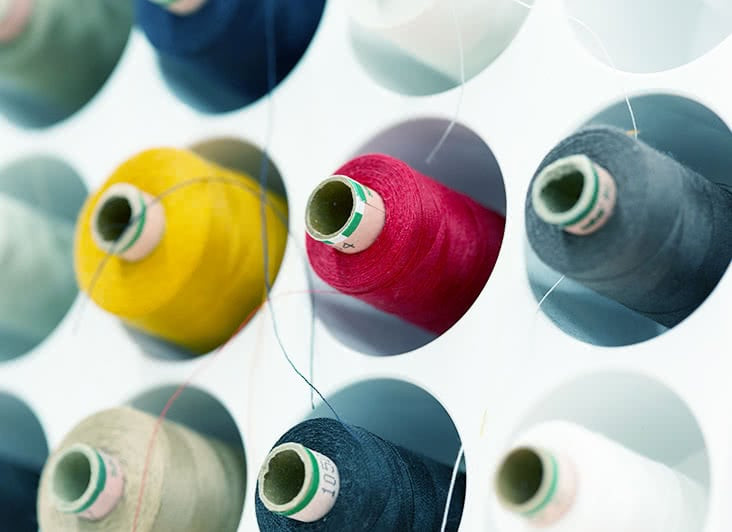processes & chemicals

Our Environmental Standards for Suppliers
Clearly defined standards apply to our suppliers with regard to environmental protection which, among other things, we have laid down as mandatory in the Supplier Code of Conduct. The principles of environmental protection set out in the HUGO BOSS Environmental Policy, which is publicly available, also apply to all of the Company's suppliers. In addition to climate protection, the policy also includes chemical and wastewater management and other environmental aspects. The most far-reaching requirements apply to suppliers whose production processes have the highest environmental and climate impact.
We check our environmental requirements regularly. Audits are necessary for facilities which are resource-intensive, and discharge industrial wastewater. We categorize as resource-intensive suppliers those who use coal and/or discharge more than 15m3 of water daily. In this context, particular attention is paid to the prevention of hazardous substances and compliance with wastewater guidelines in accordance with the Zero Discharge of Hazardous Chemicals (ZDHC) initiative.
If a partner fails to satisfy the demands of HUGO BOSS, the company draws up corrective action plans, aimed at rectifying the shortcomings.
Eliminating hazardous substances
Producing leather and textile products requires the use of chemicals in several steps along the supply chain. Together with its suppliers, HUGO BOSS works toward ensuring that these chemicals are used responsibly. HUGO BOSS requires its suppliers and employees to comply with and implement the requirements outlined in the HUGO BOSS Chemical Management Policy. The aim is to ensure that product development and production happen in a way that is less harmful to the environment, which means that we use resources like water and chemicals responsibly. This is not only to improve safety for customers and industrial workers, but also as a key factor in minimizing the supply chain’s environmental impacts. That’s why HUGO BOSS also works together with industry-wide initiatives like ZDHC and strives to optimize the use of materials and its production processes in regards to the use of chemicals and wastewater management together with its suppliers.

-
Raw materials
Different chemicals are used in the production of fabric and trimmings – whether as pesticides in cotton cultivation, in the production of synthetic fibers or in the finishing of fabrics.
To reduce the use of chemicals, HUGO BOSS works toward using materials from more sustainable production in larger amounts.
-
Manufacturing
Our natural capital evaluation showed that, in particular, processes using water or chemicals in production – such as dyeing or tanning – have major environmental impacts due to high water and energy consumption, as well as potential pollution. If hazardous substances are released via the wastewater without pre-treatment for example, this can affect water quality and thus also the water supply for local communities. HUGO BOSS is working intensively with its partners to reduce hazardous chemical usage or switch to alternatives with less impact on the environment and operate a functioning wastewater treatment. An important tool for this is the introduction of effective chemical management in the supply chain.
In order to minimize health and environmental risks, we demand responsible handling of chemicals from our suppliers in our environmental program. To support them in this, we have been a member of the ZDHC Roadmap to Zero Program since 2017. The program is based on the ZDHC Manufacturing Restricted Substances List (ZDHC MRSL), which lists hazardous chemicals which cannot be present in chemical formulations above a defined threshold value. This, in combination with educational material and training, helps our partners to reduce the use of chemicals and replace hazardous substances. In addition, water pollution prevention is also an important goal of the ZDHC Program. For facilities with wet processes that generate industrial wastewater, chemical management therefore includes a functioning wastewater management system, and provides guidance on testing this wastewater for hazardous substances. The ZDHC Program also enables a standardized assessment of a supplier's chemical management.
-
Final product
To care for the health and safety of the people who come into contact with HUGO BOSS products, the company observes high safety standards. For this reason, in particular, compliance with the HUGO BOSS Restricted Substance List (RSL) is mandatory for partners and suppliers at every stage in the supply chain.
With the HUGO BOSS RSL, the company defines strict maximum amounts of specific chemicals that can be contained in products. Compliance is verified by regular product tests that HUGO BOSS commissions third-party laboratories. The RSL is regularly updated and is based on the RSL of the industry-wide Apparel & Footwear International RSL Management (AFIRM) Group initiative, which HUGO BOSS is member of.
OUR DYES AND TREATMENTS
Most of our products have been dyed and treated to give them their unique appearance. We strive to reduce our impact on the environment when using dyes and special treatments, by limiting the use of harmful chemicals excessive quantities of water.
CLIMATE PROTECTION IN THE SUPPLY CHAIN

Targets on more sustainable production processes at suppliers
-
100% of Tier 1 and direct Tier 2 suppliers with wet processes produce in compliance with the ZDHC MRSL or comparable standards by 2030
We have set a target that by 2030, all Tier 1 and direct Tier 2 suppliers with wet processes will be producing in compliance with the ZDHC MRSL standards or comparable standards (measured by their wastewater tests and chemical inventory).
We have set the target for all strategic Tier 1 suppliers with wet processes for 2025 as a milestone
Status 2024: 42% for chemical inventory & 62% for wastewater tests (strategic suppliers: 65% for chemical inventory & 85% for wastewater reports)
-
100% of suppliers with a high environmental impact comply with the environmental requirements defined by HUGO BOSS by 2025
We have set the target that by 2025, all suppliers with a high environmental impact will comply with the environmental requirements defined by HUGO BOSS. This means they:
- Comply with national environmental legislation,
- Contribute to the implementation of the ZDHC alliance’s standard, and
- Support the Fashion Industry Charter for Climate Action of the UNFCCC
Status 2024: 74%